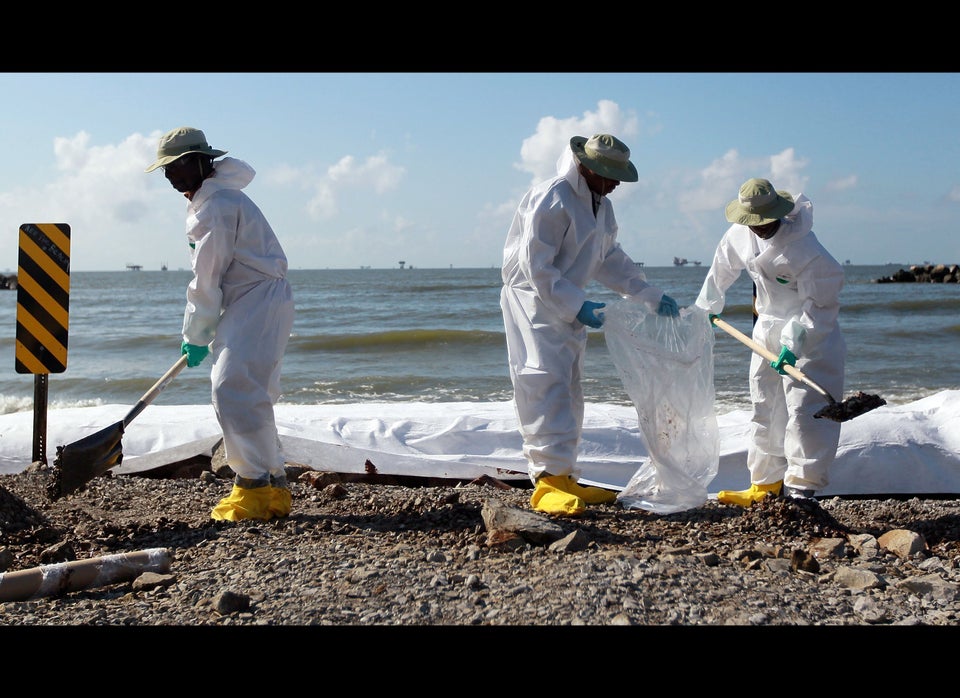
Federal officials arrested a former BP engineer on charges of obstruction of justice on Tuesday, in the first criminal charges filed in connection with the 2010 Deepwater Horizon oil spill in the Gulf of Mexico.
Kurt Mix, 50, a senior BP drilling engineer, allegedly destroyed hundreds of text messages sent to a supervisor that described high volumes of oil flowing from the ruptured well, located 5,000 feet underwater, according to a federal affidavit.
Mix "worked on internal BP efforts to estimate the amount of oil leaking from the well and was involved in various efforts to stop the leak," the Justice Department said in a press release.
Throughout the spill, BP consistently provided flow estimates to the government and public that were later revealed to be far lower than the actual discharge from the well. For the first two months of the spill, BP claimed that its best estimate for the flow from the well was between 1,000 to 5,000 barrels of oil per day.
The official government estimate, made using measurements directly from the wellhead, concluded that the flow was more than 50,000 barrels per day.
The criminal charges may validate concerns raised by scientists, elected officials and environmental groups that BP officials deliberately misled the government and the public about how much oil was leaking from the ruptured well.
Mix faces up to 20 years in prison on the felony obstruction of justice charges and up to $500,000 in fines, according to the Justice Department. Mix, who retired from BP in 2011, is scheduled to appear in federal court in Houston this afternoon.
BP released a brief statement in response to the charges on its website.
"We will not comment on the government's case against former BP employee Kurt Mix and we will continue cooperating in the Department of Justice's investigation," the company said.
BP added that it had "clear policies requiring preservation of evidence in this case" and said that it has undertaken "substantial and ongoing efforts to preserve evidence" in the criminal investigation into the spill.
During the spill, Rep. Edward J. Markey (D-Ma.), then-chairman of the Select Committee on Energy Independence and Global Warming, repeatedly queried BP officials about the amount of oil flowing from the uncontrolled well, and pushed the company to release video of the leak, which quickly led to independent estimates that were far higher than those provided by BP.
In a statement Tuesday, Markey said that BP had a "policy of obfuscation" when it came to estimating the well's flow, and said that the company "may have had reason to know" that highly publicized efforts to plug the leak were doomed to failure before they were implemented.
"The courts will determine whether these actions were an obstruction of justice, but we already know that BP had a policy of obfuscation during the spill when it came to the amount of oil flowing out of the Macondo well," Markey said.
Jackie Savitz, a senior scientist with Oceana, an environmental group, said independent and government reports about BP's practices had shown a long history of deception by the company.
In drilling applications for the Deepwater Horizon well, she said, BP told government regulators that the company was fully prepared to handle an oil spill even larger than the one that resulted from the April 20, 2010 blowout. The company's assurances were proven disastrously wrong within days of the disaster.
"Anybody who thinks BP is credible is not paying attention," Savitz said.
The charges come just days after BP finalized a $7.8 billion settlement with over 100,000 businesses and individuals harmed by the spill.
But still looming for the company is a massive civil trial that pits BP and its corporate partners on the doomed Deepwater Horizon rig against the federal government and a half-dozen Gulf states.
Federal and state claims could yield penalties and fines totaling as much as $60 billion, legal experts said.
More criminal charges related to the spill could also be forthcoming. Investigations by the Coast Guard and an independent commission created by President Obama found that BP shared responsibility for the rig explosion with other contractors on the well, including Transocean, which owned the rig, and Halliburton, which poured the concrete designed to seal the well.
"The Deepwater Horizon Task Force is continuing its investigation into the explosion and will hold accountable those who violated the law in connection with the largest environmental disaster in U.S. history," said U.S. Attorney General Eric Holder in a statement Tuesday.
According to the criminal complaint, Mix, a senior drilling engineer with BP, was involved in efforts to stop the oil leak, which culminated with a high-stakes attempt over three days in late May 2010 to plug the well by injecting heavy fluids and other material into it from ships on the surface.
In October 2010, Mix allegedly deleted hundreds of text messages exchanged with a supervisor about the operation to plug the well, called "Top Kill" by company officials. The messages were deleted after Mix was informed that the contents of his phone were being sought by a contractor working for BP's attorneys. Mix had been repeatedly notified through official channels that he was to preserve all communications related to the spill, according to the government.
Those text messages indicated that the operation was failing because the flow of oil and gas from the well was too high to overcome from above, the criminal complaint said.
"Too much flowrate -- over 15,000 and too large an orifice," Mix wrote at 10:25 p.m. on May 26, the first day of the Top Kill operation. "Tired. Going home and getting ready for round three tomorrow."
In a press release, the Justice Department said that at that time, BP's public estimate of the flow rate was just 5,000 barrels per day, "three times lower than the minimum flow rate indicated in Mix's text." According to a report by the presidential commission investigating the spill, BP and outside engineers had concluded that the Top Kill operation would fail if the flow from the well was higher than 15,000 barrels per day.
In August 2011 Mix deleted more than 100 additional text messages that were exchanged with a BP contractor with whom he was working on issues related to the flow of oil from the well, the government said.
Throughout the spill, BP officials told Congress and the public that the company lacked the technical ability to measure flow from the deep-sea gusher. The company maintained that its best estimate of the spill was based on surface measurements and was roughly 5,000 barrels per day, according to senior government officials involved in the spill response.
In August 2011, however, an oil industry consultant who was directly involved in the effort to plug the well at BP's U.S. headquarters in Houston told The Huffington Post that BP had data in early May indicating that the well flow rate was "much higher" than 5,000 barrels per day.
"Our calculations suggested to us that it was much higher than the number that was being talked about," said the consultant, who requested anonymity because of his proximity to pending litigation over the disaster.
The top kill operation had a "very, very low likelihood of working based on the volumes we were seeing from the well," he added.
Before and during the late May attempt to plug the well, former BP chief executive Tony Hayward declared publicly that the top kill operation had a 60 to 70 percent chance of success.
This story is developing.
